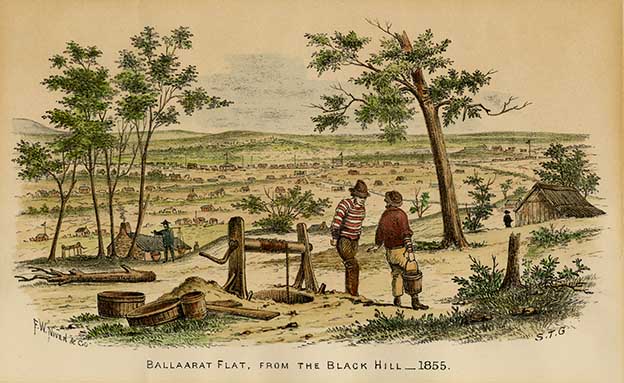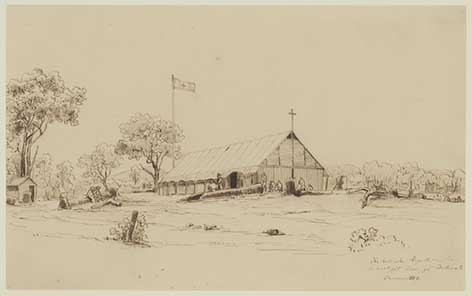George Goddard
Contents
Background
Henry Goddard, a tailor, was the father of George Goddard who was born in Suffolk, England. George Goddard arrived in Ballarat in 1851. He married Sarah Phillips on 20 December 1854 at St Mary's Geelong. He died in January 1912 aged 82 and was buried at Ballaarat Old Cemetery.
Goldfields Involvement, 1854
Goddard was a wounded bystander during the Eureka Stockade battle.[1] After the Eureka Battle George Goddard was arrested and chained to Timothy Hayes.[2] He was charged with riot of 30 November 1854 on 17 January 1855. At the time of his arrest he was living in a tent. He was tried, along with John Chapman, Benjamin Ewinds, Duncan McIntyre, William Bryant and Donald Campbell. All pleaded not guilty to the charge of sedition and riot. Goddard was defended by Mr Cope and Mr Prendergast. [3]
- George Goddard stands charged before the undersigned one of Her Majesty’s Justices of the Peace in and for the Colony of Victoria, this 30th day of November 1854 at Ballarat in the said Colony did with others tumultuously and riotously assemble and did then and there cause a break of the peace and the said charge being read to George Goddard and the Witness for Prosecution Samuel Purnell and William Nolan being severally examined in my presence, the said George Goddard is now addressed by me as flows. – Having heard the evidence do you wish to say anything in answer to the charge, you are not obliged to say anything unless you desire to do so, but whatever you say will be taken in writing, and may be given in evidence against you upon your trial, whereupon the said [blank] saith as follows: My wife is taken bad this morning. I went and got my horse at Hirt’s Black Hill. I came to Mrs Derby. She was not at home. I went to another place. I went to one of my friends a ember of the Catholic Chapel. She was not there. I was coming home when I was taken.
George Goddard (his mark)<ref.Statement of accused, the result of which he was committed for trial at the Supreme Court of Criminal Sessions, Melbourne 15 December 1854.</ref>
Post 1854 Experiences
Obituary
- The links of the past and present of Ballarat are gradually dropping out, and another, in the person of Mr George Goddard, passed away last night at the residence of his daughter, East Street. Mr Goddard had been in bad health for some time, and he had been unable to get about very much. Latterly, however, he had been confined to his room and unable to take nourishment, and his death was by no means unexpected. Deceased was 81 years of age, and a native of Suffolk, England. He was a colonist of over 60 years, and, like most of the early colonists, he tried his luck on the diggings with various success. He was associated with the diggers in the Eureka Riot, and ever since he was a familiar figure about Ballarat East. He was one of the oldest, if not the oldest, members of the Ballarat Fire Brigade Club. He joined the brigade under the volunteer system in 1861, and at all public demonstrations of the fireman or club members of recent years”Dad” Goddard, as he was familiarly called, was prominent in his scarlet uniform. He leaves five sons – Messrs Harry, George, Albert, Jack and Walter – And five daughters. [4]
See also
Further Reading
Corfield, J.,Wickham, D., & Gervasoni, C. The Eureka Encyclopaedia, Ballarat Heritage Services, 2004.

